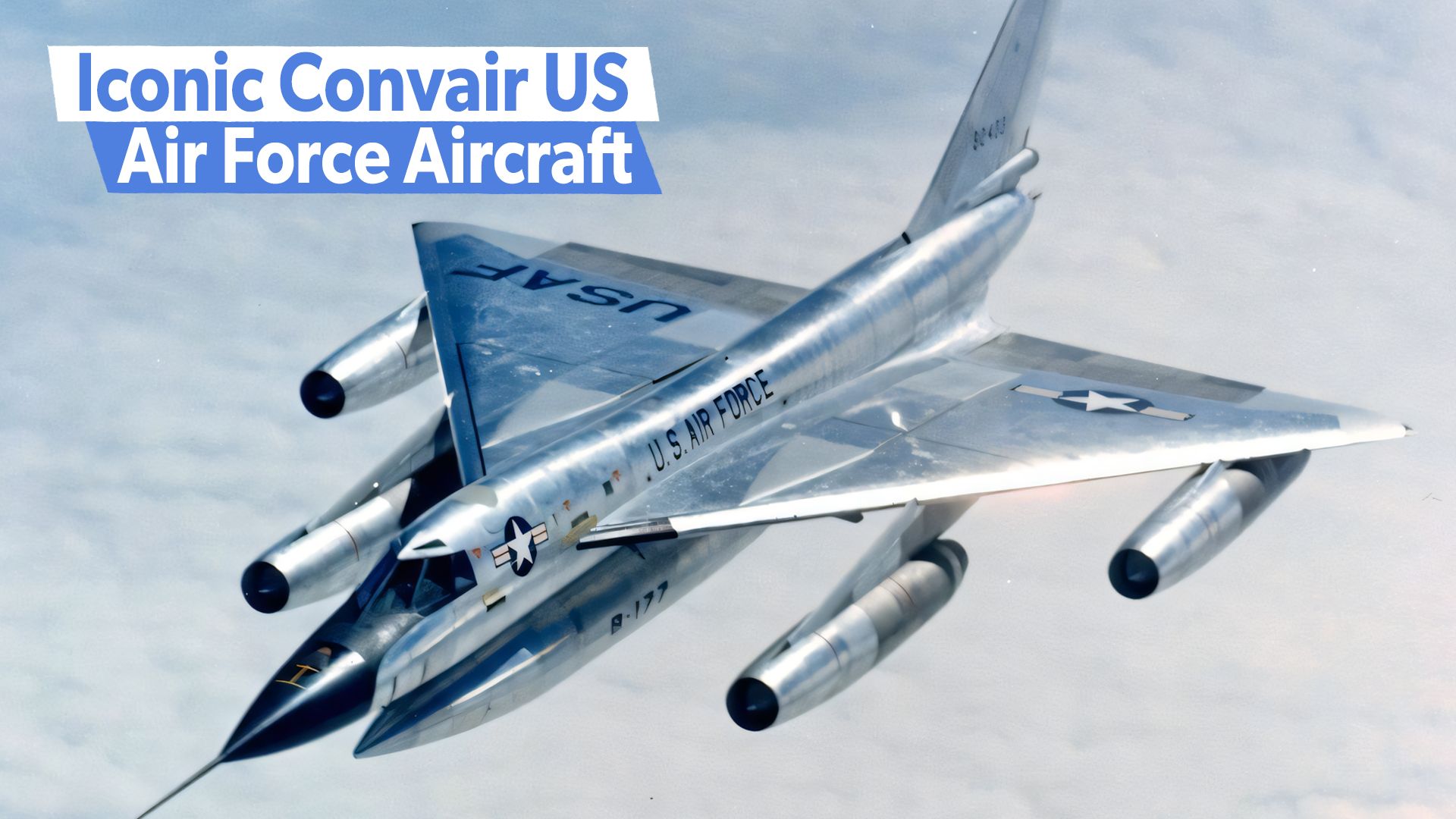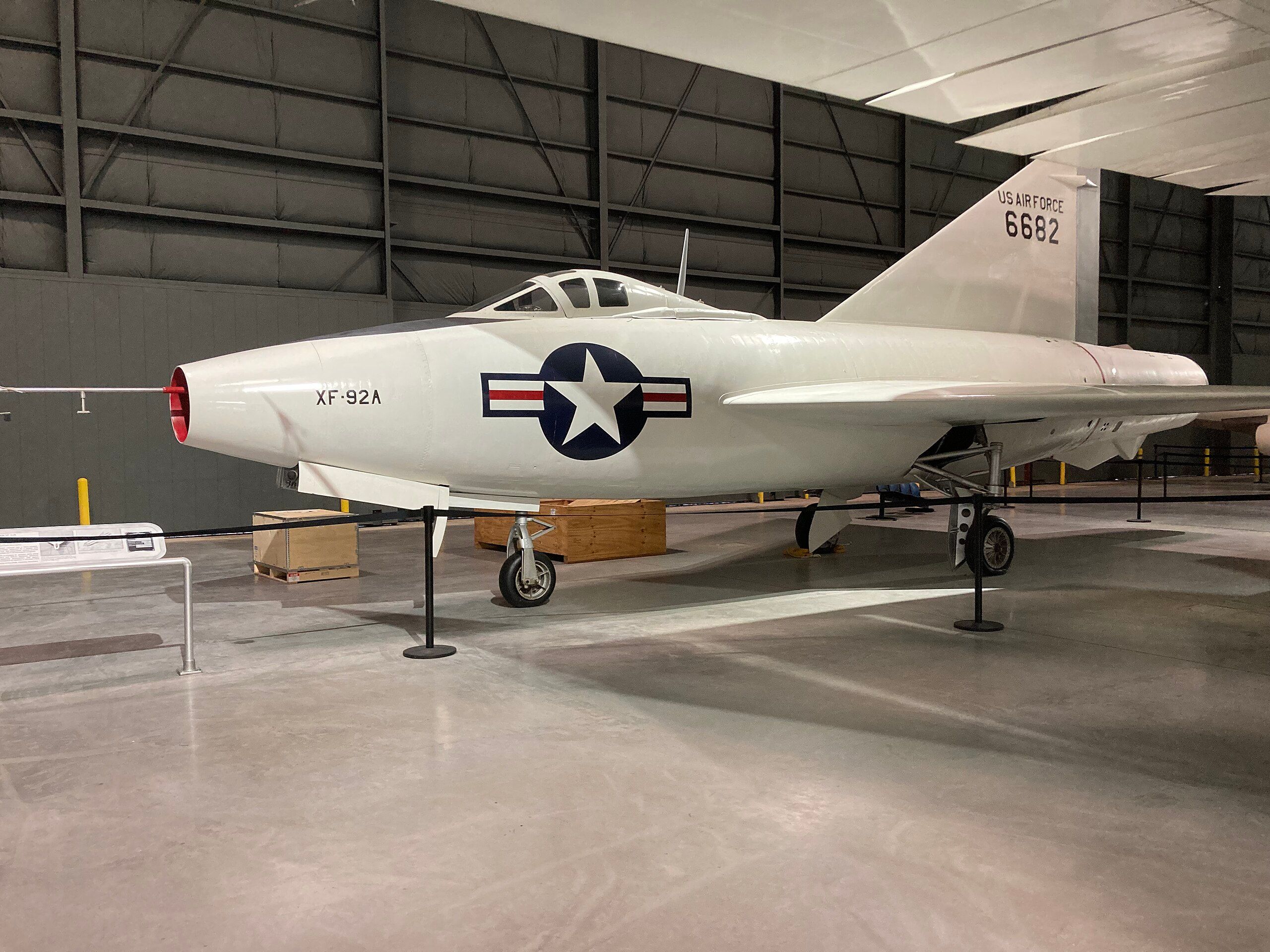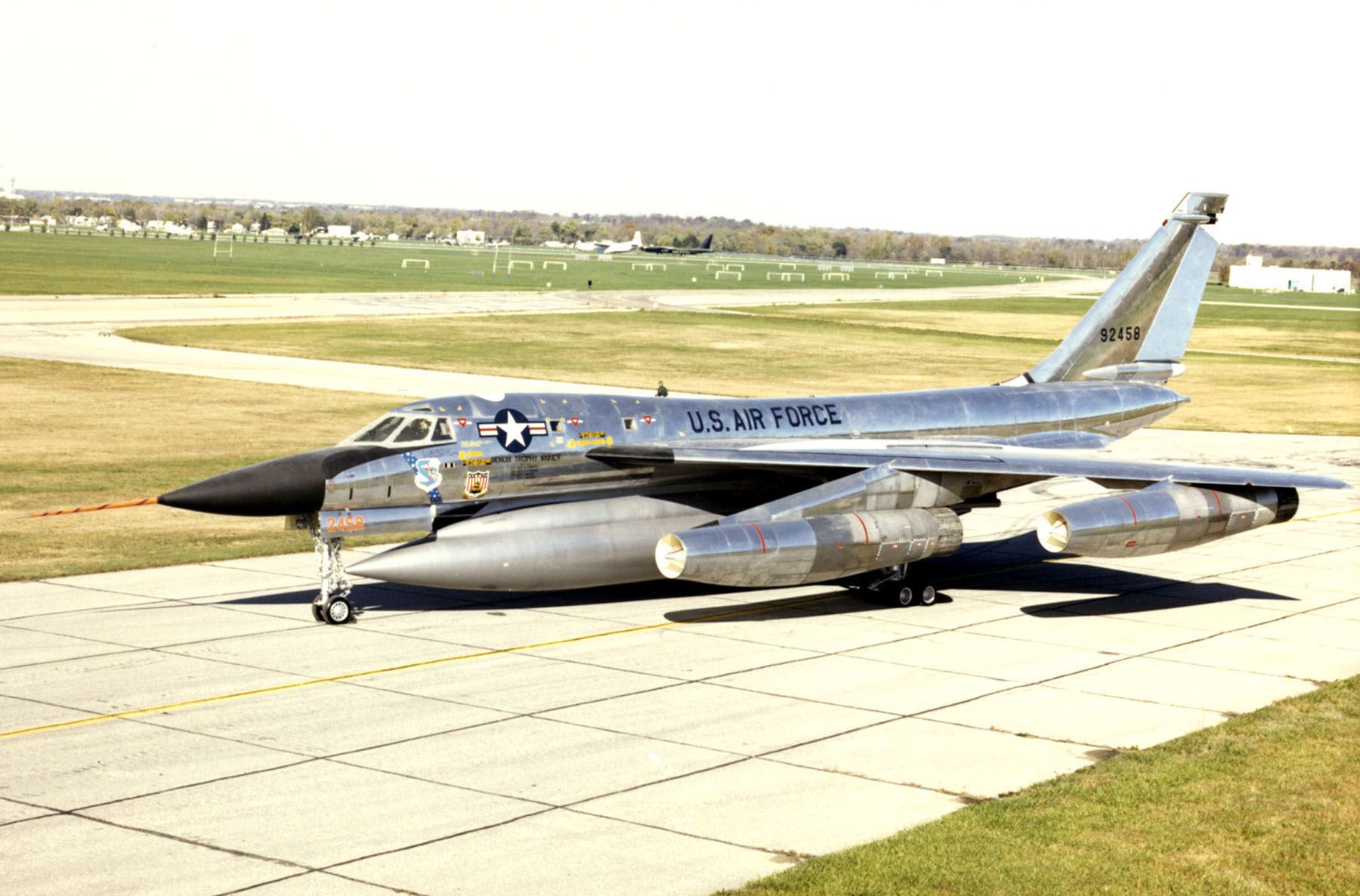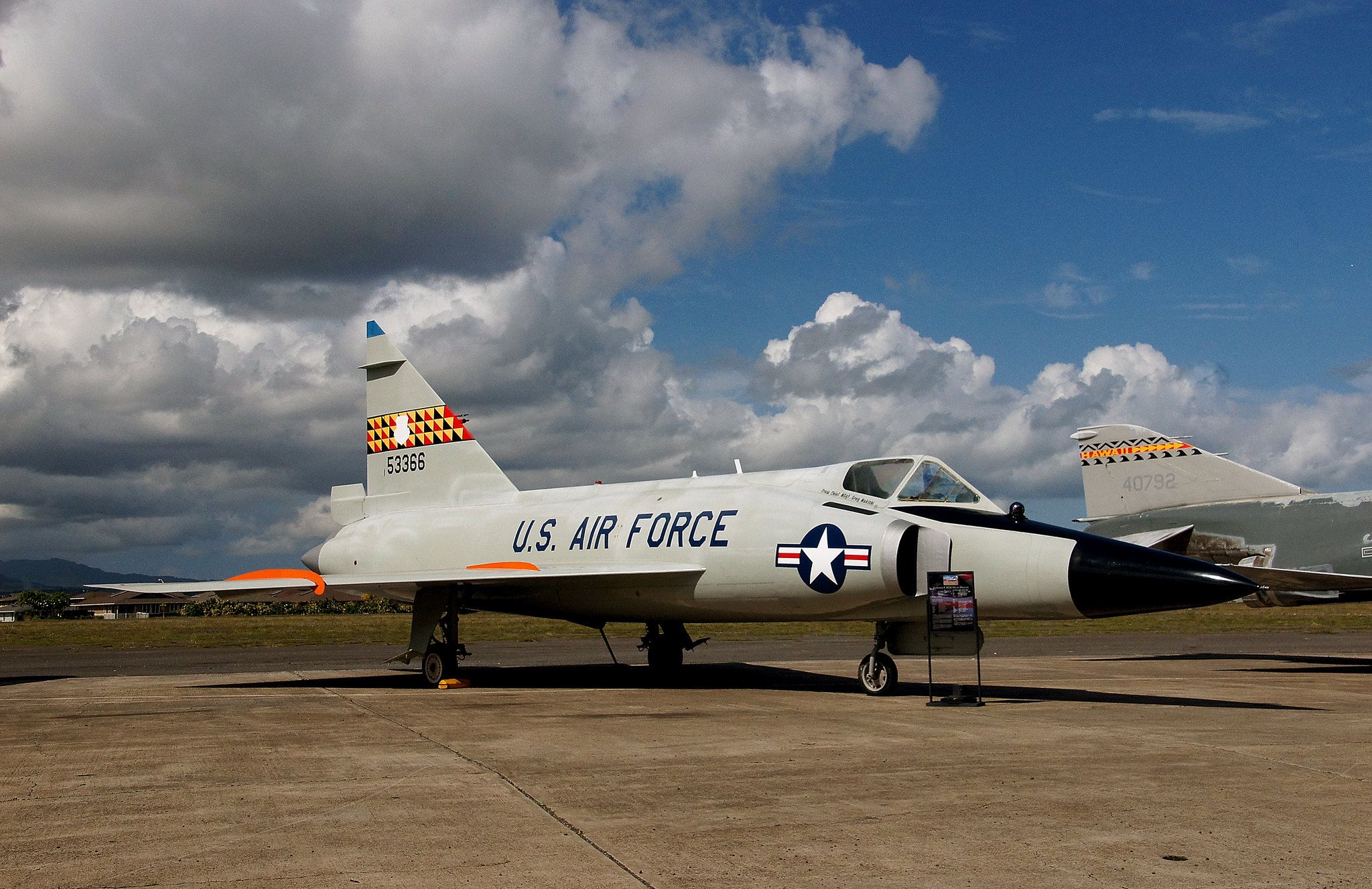Convair aircraft have played a major role in the history of US military aviation. The American aircraft manufacturer produced some of the most iconic military aircraft, from experimental aircraft to interceptors and bombers. This article explores the most iconic of Convair’s lineup.
1
Convair XF-92A
The first US Delta Wing aircraft
- Crew: 1
- Length: 42 ft 6 in (12.95 m)
- Wingspan: 31 ft 4 in (9.55 m)
- Height: 17 ft 9 in (5.41 m)
- Maximum speed: 718 mph (1,156 km/h, 624 kn)
- Service ceiling: 50,750 ft (15,470 m)
The Convair XF-92 was a first-generation jet prototype designed and developed by Convair in the mid-1940s. The type performed its maiden flight in September 1948. Featuring a delta wing, the XF-92 was conceived as an interceptor aircraft for critical defense missions. It was later decided that the only prototype built would be used purely for experiments.
The aircraft was powered by a single Allison J33-A-29 afterburning turbojet engine, generating 4,500 lbf (20 kN) thrust dry and 7,500 lbf (33 kN) with afterburner. While no production aircraft were built, the type led Convair to use delta-wing design on numerous future aircraft.
2
Convair B-58 Hustler
The first operational bomber capable of Mach 2 flight
- Crew: Three
- Length: 96 ft 10 in (29.51 m)
- Wingspan: 56 ft 9 in (17.30 m)
- Height: 29 ft 11 in (9.12 m)
- Max takeoff weight: 176,890 lb (80,236 kg)
- Maximum speed: Mach 2.0
- Range: 4,100 NM (4,700 mi, 7,600 km)
- Combat range: 1,740 NM (2,000 mi, 3,220 km)
- Service ceiling: 63,400 ft (19,300 m)
The Convair B-58 was the first operational bomber capable of Mach 2 flight. Designed by Convair for the United States Air Force (USAF), the aircraft performed its maiden flight in November 1956 and was introduced into service in March 1960.
Photo: National Museum of the US Air Force
Featuring a delta wing, the aircraft showed its power through speed and agility. Although the initial design did not include a bomb bay, four hardpoints were later added, allowing a capacity of five weapons, including an original single nuclear weapon.
The aircraft was powered by four General Electric J79-GE-5A afterburning turbojet engines, each generating 10,400 lbf (46 kN) thrust dry and 15,000 lbf (67 kN) with afterburner. Convair produced 116 examples of the B-58.
3
Convair B-36 Peacemaker
The largest mass-produced piston-engined aircraft ever built
- Crew: 13
- Length: 162 ft 1 in (49.40 m)
- Wingspan: 230 ft 0 in (70.10 m)
- Height: 46 ft 9 in (14.25 m)
- Max takeoff weight: 410,000 lb (185,973 kg)
- Maximum speed: 435 mph (700 km/h, 378 kn)
- Combat range: 3,985 mi (6,413 km, 3,463 NM)
- Ferry range: 10,000 mi (16,000 km, 8,700 NM)
- Service ceiling: 43,600 ft (13,300 m)
The Convair B-36 Peacemaker was a strategic bomber designed and developed for the USAF. The USAF operated a large fleet of bomber between 1949 and 1959. The aircraft performed its maiden flight in August 1946 and was introduced into service in April 1948. It was the largest mass-produced piston-engined aircraft ever built.
With an operational ferry range of 8,700 NM (16,000 km), the B-36 could perform intercontinental flights without refueling. The aircraft was powered by six Pratt & Whitney R-4360-53 Wasp Major 28-cylinder 4-row air-cooled radial piston engines, each generating 3,800 hp (2,800 kW) at take-off.
A different version with four General Electric J47 turbojet engines, each with 5,200 lbf (23 kN) thrust, was also developed. Between 1946 and 1954, 384 examples of the B-36 were produced.
4
Convair F-102 Delta Dagger
The first operational supersonic interceptor and delta-wing fighter operated by the USAF
- Crew: 1
- Length: 68 ft 4 in (20.83 m)
- Wingspan: 38 ft 1 in (11.61 m)
- Height: 21 ft 2.5 in (6.464 m)
- Max takeoff weight: 31,500 lb (14,288 kg)
- Maximum speed: Mach 1.25, Mach 0.95 with drop tanks
- Range: 1,350 mi (2,170 km, 1,170 NM)
- Service ceiling: 53,400 ft (16,300 m)
The Convair F-102 Delta Dagger was an interceptor aircraft designed and developed by Convair in the early 1950s. The aircraft performed its first flight in October 1953 and was introduced into service in April 1956. It was the first operational supersonic interceptor and delta-wing fighter that the USAF operated.
Despite its maximum speed of Mach 1.25 (without drop tanks), the aircraft lacked range compared to other similar jets. It possesses an operational range of 1,170 NM (2,170 km). The aircraft was powered by a single Pratt & Whitney J57-P-25 afterburning turbojet engine, generating 11,700 lbf (52 kN) thrust dry, and 17,000 lbf (76 kN) with afterburner. A total of 1,000 examples of the F-102 aircraft were produced by Convair.
5
Convair F-106 Delta Dart NASA Lightning Strike Plane
It was struck by lightning 714 times without damage
- Crew: 1
- Length: 70 ft 8 in (21.55 m)
- Wingspan: 38 ft 3 in (11.67 m)
- Height: 20 ft 3 in (6.18 m)
- Maximum speed: Mach 2.3
- Combat range: 500 NM (580 mi, 930 km) with internal fuel
- Ferry range: 2,346 NM (2,700 mi, 4,345 km)
- Service ceiling: 57,000 ft (17,000 m)
The Convair F-106 Delta Dart was an all-weather interceptor aircraft designed and developed by Convair in the mid-1950s. The aircraft performed its first flight in December 1956 and was introduced into service in June 1959. Designed in response to the 1956 interceptor program, it was struck by lightning over 700 times without damage.
Despite its maximum speed of Mach 1.25 (without drop tanks), the aircraft lacked range compared to other similar jets. It possesses an operational range of 1,170 NM (2,170 km). The aircraft was powered by a single Pratt & Whitney J75-P-17 afterburning turbojet engine, generating 16,100 lbf (72 kN) thrust dry, and 24,500 lbf (109 kN) with afterburner. Convair produced more than 340 examples of the F-106.






